Circular 653
Rossana Sallenave, Carl Carrasco, and David E. Cowley
College of Agricultural, Consumer and Environmental Sciences, New Mexico State University
Authors: Respectively, Extension Aquatic Ecology Specialist, Department of Extension Animal Sciences and Natural Resources; Former Research Assistant, Department of Fish, Wildlife, and Conservation Ecology; and Associate Professor, Department of Fish, Wildlife, and Conservation Ecology, New Mexico State University. (Print Friendly PDF)
Introduction
New Mexico and the southwestern United States have been transformed by the construction and widespread development of irrigation systems. Irrigation has allowed agriculture, urban growth, and economic development to flourish in regions where it would otherwise have been impossible. However, it has also taken a heavy toll on river ecosystems, most of which have been greatly altered and depleted due to dam-flow regulation and water over-extraction. In New Mexico and other arid regions, the water supply in many rivers has been over-allocated for human uses so that, in climatically dry periods, rivers go completely dry while the adjacent irrigation systems may have all the available water.
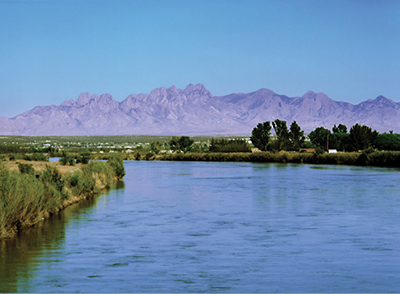
Because the Rio Grande has been highly altered, it has been named as one of the top ten most endangered rivers in the world (Wong et al., 2007). Most of the main river channel has been modified by a series of dams and irrigation diversions, which have altered its flow, discharge, and biodiversity (Sublette et al., 1990; Cowley, 2006; Smith and Fernald, 2006). Irrigation is the primary use of the Rio Grande surface flow throughout the basin. Despite all these modifications to the river, fish continue to persist in the Rio Grande. At least 166 species of fishes have been found in the Rio Grande, of which 86 are freshwater species (Dahm et al., 2005). However, many of the fishes in the Rio Grande today are not native to the river. Many species were introduced purposely for sport fishing by state and federal agencies, or negligently by anglers or aquarium enthusiasts unaware of regulations and of the ecological impacts of their actions. The fishes of the Rio Grande basin were once dominated by a rich minnow assemblage including the federally endangered Rio Grande silvery minnow (see Figure 1). But most of these unique species, along with most of the large-bodied native fishes, have been eliminated. Of the 27 species of fishes that were historically native to the Rio Grande in New Mexico, only 14 remain (Cowley, 2006). One of the greatest problems for the fishes of the Rio Grande Basin is the dewatering of the river channel, which occurs when the irrigation season coincides with periods of drought. In these circumstances, irrigation canals retain water and can provide refugial habitat for fish during periods when large sections of the river are dry, allowing them to survive until flows are restored to the river.
Figure 1. Native and nonnative minnow species (Cyprinidae) commonly found in the Rio Grande irrigation system. Illustrations provided by Joe Tomelleri (www.americanfishes.com).
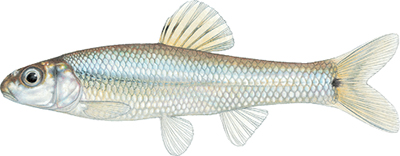
Bullhead minnow
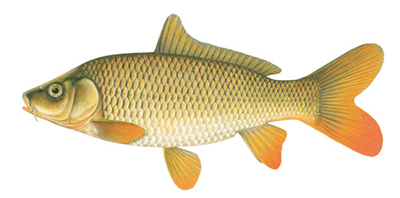
Common carp

Fathead minnow female
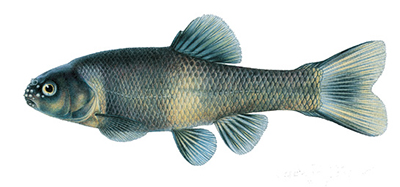
Fathead minnow male
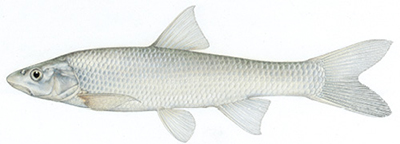
Flathead chub
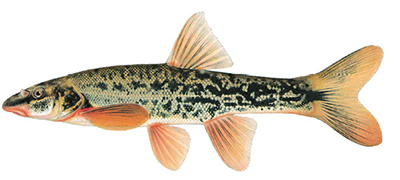
Longnose dace
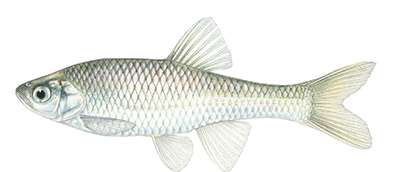
Red shiner female
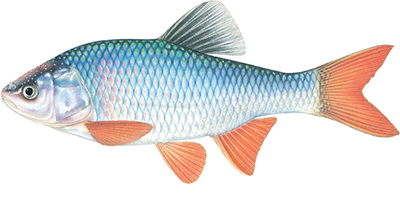
Red shiner male
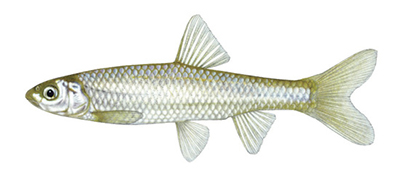
Rio Grande silvery minnow
This circular is the result of fish surveys conducted by the authors. It provides a list of all fish species found in the irrigation canals along the Rio Grande of New Mexico (Figures 1 and 2). The study focused on the lower two-thirds of the river in New Mexico, and divides the area into two regions. The Middle Rio Grande lies between Cochiti Dam to the north and Elephant Butte Reservoir to the south. The Middle Rio Grande Conservancy District maintains over 1,200 miles of irrigation ditches and canals (Dumars and Nunn, 1993) that transfer water to and from 70,000 acres of croplands located between Cochiti Dam and the Bosque del Apache National Wildlife Refuge. The Lower Rio Grande is the segment from Elephant Butte Reservoir to El Paso, Texas. The Lower Rio Grande is largely canalized and serves to deliver irrigation and municipal water from Elephant Butte and Caballo Reservoirs. Elephant Butte Irrigation District is the agency responsible for water deliveries to over 90,000 acres of irrigated land via its extensive network of diversion dams, canals, and drains. The purpose of this circular is to promote a better understanding of how irrigation canals can provide habitat for fishes even when the main river is dewatered. Angling enthusiasts who use these areas for recreational fishing will recognize many of the species mentioned. In addition, the circular suggests ways that irrigation canals could promote conservation of native species while continuing to support municipal and agricultural water uses.
Figure 2. Game and other fish species found in the Rio Grande irrigation system. Illustrations provided by Joe Tomelleri (www.americanfishes.com).
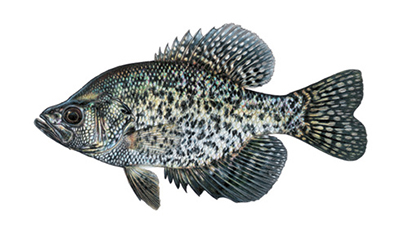
Black crappie
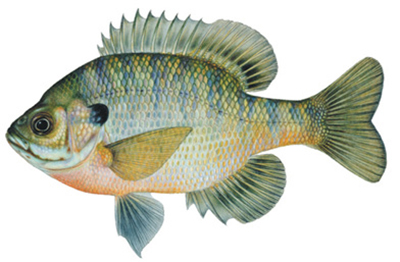
Bluegill
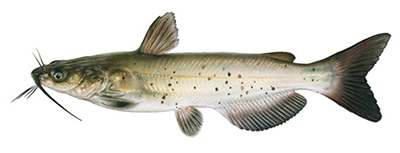
Channel catfish female
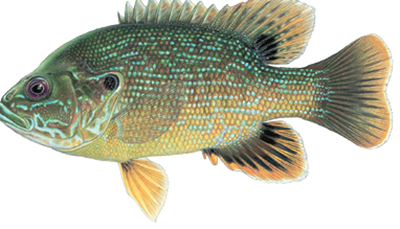
Green sunfish
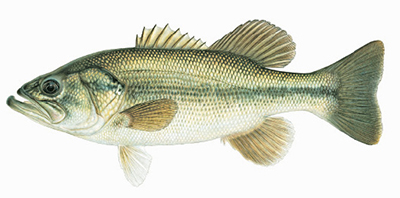
Largemouth bass
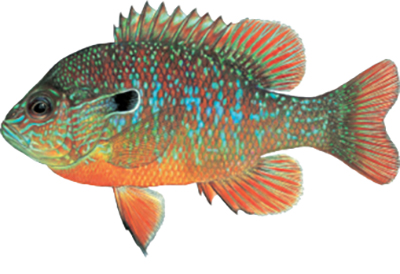
Longear sunfish
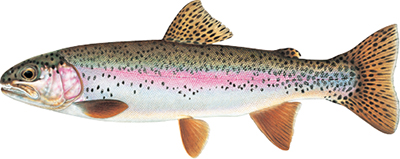
Rainbow trout
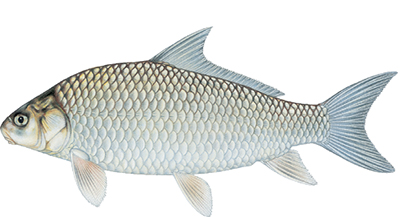
River carpsucker
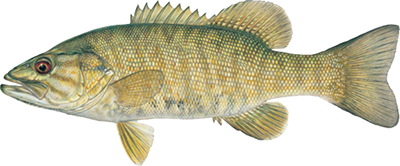
Smallmouth bass
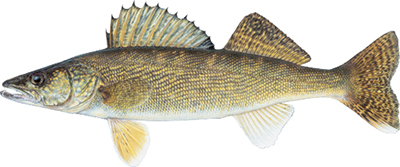
Walleye
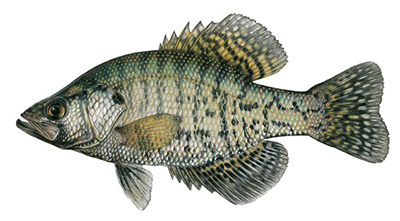
White crappie male
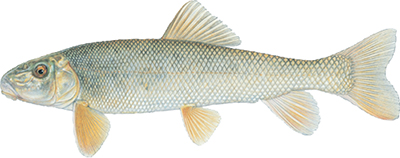
White sucker
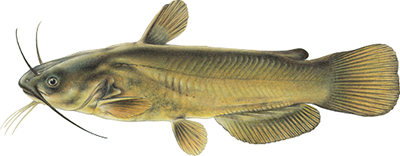
Yellow bullhead
The Irrigation Systems
The irrigation networks in New Mexico consist of canals with various characteristics. There are many names for these different canal types. A basic nomenclature of canals, consistent with the usage in this guide, along with the purposes of these different types of canals, can be seen in Table 1. Some of the names for canals date to Spanish colonial days in New Mexico. Other names, like "wasteway," convey the commodity nature of water in New Mexico and the lack of social value placed on water in a river ecosystem.
Fishes of the Rio Grande Irrigation Systems
Fishes of the Middle Rio Grande irrigation system
In 2002, researchers at New Mexico State University, supported by the USDA-funded Rio Grande Basin Initiative, began a survey of fishes in different types of irrigation canals within the Middle Rio Grande Conservancy District, focusing most of the sampling effort on drain canals and return canals (Table 1). These surveys netted a total of 27 fish species, 16 nonnative species and 11 native species (Table 2). The most abundant native species have been fathead minnows (Pimephales promelas), red shiners (Cyprinella lutrensis), and the endangered Rio Grande silvery minnow (Hybognathus amurus). In many individual samples, the Rio Grande silvery minnow has been the most abundant species, making up 35% or more of all fishes. It has been suggested that the Rio Grande silvery minnow is adept at finding irrigation return flows, possibly because water in return canals is cooler than water in the river. The most abundant nonnative species have been channel catfish (Ictalurus punctatus) and largemouth bass (Micropterus salmoides)"both fish-eating predators" and white sucker (Catostomus commersonii), an invasive species.
|
Table 1. The Nomenclature of Irrigation Canals in New Mexico |
||
|
Canal Type |
Other Names in Use |
Purpose |
|
Canal |
Main canal, lateral, ditch, acequia, acequia madre, conveyance canal |
Deliver water from the Rio Grande to water users |
|
Drain canal |
Drain, clear ditch |
Drain excess water from fields, prevent waterlogging of soils by intercepting shallow groundwater, provide |
|
Return canal |
Wasteway |
Return water from the irrigation system to the Rio Grande |
|
Table 2. Fishes in Irrigation Systems along the Rio Grande of New Mexico. The Middle Rio Grande (MRG) and the Lower Rio Grande (LRG) are represented. N denotes a native species, X denotes presence. Most sampling in the MRG was in drain and return canals. |
|||||
|
Scientific Name |
Common Name |
Native |
MRG |
LRG Canals |
LRG Dain Canals |
|
Family Clupeidae |
Shads |
||||
|
Dorosoma cepedianum |
Gizzard shad |
N |
X |
X |
X |
|
Dorosoma petenense |
Threadfin shad |
X |
|||
|
Family Cyprinidae |
Minnows |
||||
|
Cyprinella lutrensis |
Red shiner |
N |
X |
X |
X |
|
Cyprinus carpio |
Common carp |
X |
X |
X |
|
|
Hybognathus amarus |
Rio Grande silvery minnow |
N |
X |
||
|
Pimephales promelas |
Fathead minnow |
N |
X |
X |
X |
|
Pimephales vigilax |
Bullhead minnow |
X |
X |
X |
|
|
Platygobio gracilis |
Flathead chub |
N |
X |
||
|
Rhinichthys cataractae |
Longnose dace |
N |
X |
X |
|
|
Family Catostomidae |
Suckers |
||||
|
Carpiodes carpio |
River carpsucker |
N |
X |
X |
|
|
Catostomus commersonii |
White sucker |
X |
|||
|
Catostomus plebeius |
Rio Grande sucker |
N |
X |
||
|
Family Ictaluridae |
Catfishes |
||||
|
Ameiurus melas |
Black bullhead |
X |
|||
|
Ameiurus natalis |
Yellow bullhead |
X |
X |
||
|
Ictalurus furcatus |
Blue catfish |
N |
X |
||
|
Ictalurus punctatus |
Channel catfish |
X |
X |
X |
|
|
Family Salmonidae |
Trouts |
||||
|
Oncorhynchus mykiss |
Rainbow trout |
X |
|||
|
Family Centrarchidae |
Sunfishes |
||||
|
Lepomis macrochirus |
Bluegill |
N |
X |
X |
|
|
Lepomis megalotis |
Longear sunfish |
X |
X |
X |
|
|
Lepomis hybrids |
Sunfish hybrids |
X |
|||
|
Lepomis cyanellus |
Green sunfish |
X |
X |
||
|
Micropterus salmoides |
Largemouth bass |
X |
X |
||
|
Micropterus dolomieu |
Smallmouth bass |
X |
X |
||
|
Pomoxis annularis |
White crappie |
X |
X |
X |
|
|
Pomoxis nigromaculatus |
Black crappie |
X |
X |
||
|
Family Percichthyidae |
Basses |
||||
|
Morone chrysops |
White bass |
X |
X |
||
|
Family Percidae |
Perches |
||||
|
Perca flavescens |
Yellow perch |
X |
|||
|
Sander vitreus |
Walleye |
X |
X |
X |
|
|
Family Poeciliidae |
Livebearers |
||||
|
Gambusia affinis |
Mosquitofish |
N |
X |
X |
X |
The fish assemblage in the canals differs between the irrigation season and the off-season. Native species are in higher abundance during the irrigation season. In contrast, nonnative species, such as largemouth bass, channel catfish, and rainbow trout (Oncorhynchus mykiss), are more prevalent during the off-season. The New Mexico Department of Game and Fish stocks rainbow trout frequently during the winter months; their impact on native minnows like the Rio Grande silvery minnow has never been studied.
Fishes of the Lower Rio Grande (Elephant Butte Irrigation District)
The system of ditches and canals making up the Elephant Butte Irrigation District also supports a number of fish species. In a study conducted at NMSU to compare species assemblages between the Lower Rio Grande and its adjacent irrigation system, Carrasco (2010) collected a total of 20 species of fish, of which 9 were native to the Rio Grande and 11 were nonnative. This result is quite remarkable given the annual frequency of drying of large sections of this reach of the Rio Grande during the irrigation off-season. Of the 20 species found, 18 were collected from river sites, 17 were from the drain canals, and 13 were from the canals (Carrasco, 2010; Table 2). The assemblage of fish typical of drain canals included three sunfish species "green sunfish (Lepomis cyanellus), longear sunfish (L. megalotis), and largemouth bass" along with mosquitofish (Gambusia affinis), common carp (Cyprinus carpio), and yellow bullhead (Ameiurus natalis). The sunfish species were rarely found in the canals or the main river. Carp in particular were found throughout the study area, but appeared in the highest concentrations in drain canals. It should be noted that most of the species inhabiting drain canals are nonnative predatory fish, which is consistent with findings from the Middle Rio Grande irrigation system (Cowley et al., 2007). Carrasco (2010) also found that overall fish diversity was greatest at drain locations closer to the river, and decreased with increasing distance from the Rio Grande.
How can irrigation systems be managed to favor the conservation of native fishes?
Surveys have shown that return canals are significant refuges for fishes during river drying. Studies elsewhere also show that irrigation systems support many aquatic species, including species considered to be "nationally scarce" (Armitage et al., 2003; Poizot et al., 1999; Williams et al., 2004). The Middle Rio Grande Conservancy District has investigated the utility of intentionally "leaking" water out of the irrigation system via the return canals to help provide refugial fish habitat during periods when the river becomes dewatered.
A persistent problem, though, is that nonnative fishes often make up the majority of species present in irrigation canals (May and Brown, 2002; Martin and Saiki, 2005). In the Middle Rio Grande irrigation system, nonnative species such as channel catfish and largemouth bass, along with invasive plants (parrotfeather) and invertebrates (rusty and virile crayfishes), are a serious problem in using drain canals as native fish habitat. Radio telemetry studies of largemouth bass suggest that they are long-term residents of the drain canals (Muldoon, 2007). Native fishes might be favored by allowing smaller fishes to pass through the irrigation system back to the river while using screens to retain larger-sized predators in the irrigation canals. This would have the added benefit of concentrating larger-sized game fishes in these sections of the drain canal and providing focused recreational fishing opportunities. Another potential strategy to favor native fishes would be to limit recreational fish stockings of rainbow trout to areas where fish movement could be controlled. By limiting movement of nonnative predators, native fish species would be given a better chance of surviving their transit through the irrigation system.
Further development of refugial fish habitats at locations where irrigation canals empty into the Rio Grande would also benefit native fishes. The occurrence of Rio Grande silvery minnows in return canals suggests that refugial habitats for this endangered species could be developed at these locations. The Middle Rio Grande Conservancy District developed experimental habitat modifications at three return canal confluences with the Rio Grande (Wesche et al., 2010). Fish sampling at those locations indicated that nonnative fish predators could be a problem in protecting native fishes.
By incorporating strategies to conserve native fishes, water managers could help protect New Mexico's biodiversity, which has intrinsic as well as economic, cultural, aesthetic, and scientific value. It is hoped that innovative solutions can be found that will protect water users and native fishes, and enable a sustainable coexistence for both in the Rio Grande Valley.
Acknowledgments
This work was supported by funding to D.E. Cowley and R. Sallenave from the Cooperative State Research, Education, and Extension Service, U.S. Department of Agriculture, under agreement numbers 2008-34461-19061 and 2008-40549-04328.
References
Armitage, P.D., K. Szoskiewicz, J.H. Blackburn, and I. Nesbitt. 2003. Ditch communities: A major contributor to floodplain biodiversity. Aquatic Conservation: Marine and Freshwater Ecosystems, 13, 165"185.
Carrasco, C.P. 2010. Comparisons of the fish fauna within the lower Rio Grande of New Mexico to the adjacent irrigation system and historical records of occurrence [Master's Thesis]. Las Cruces: New Mexico State University.
Cowley, D.E. 2006. Strategies of ecological restoration of the Middle Rio Grande in New Mexico and recovery of the endangered Rio Grande silvery minnow. Reviews in Fisheries Science, 14, 169"186.
Cowley, D.E., R.C. Wissmar, and R. Sallenave. 2007. Fish assemblages and seasonal movements of fish in irrigation canals and river reaches of the middle Rio Grande, New Mexico (USA). Ecology of Freshwater Fish, 16, 548"558.
Dahm, C.N., R.J. Edwards, and F.P. Gelwick. 2005. Gulf coast rivers of the southwestern United States. In A.C. Benke and C.E. Cushing (Eds.), Rivers of North America (pp. 181"228). Amsterdam/Boston: Elsevier Academic Press.
Dumars, C.T., and S.C. Nunn (Eds.). 1993. Middle Rio Grande Conservancy District Water Policies Plan. Albuquerque, NM.
Martin, B.A., and M.K. Saiki. 2005. Relation of desert pupfish abundance to selected environmental variables in natural and manmade habitats of the Salton Sea basin. Environmental Biology of Fishes, 73, 97"107.
May, J.T., and L.R. Brown. 2002. Fish communities of the Sacramento River Basin: Implications for conservation of natives in the Central Valley, California. Environmental Biology of Fishes, 63, 373"388.
Muldoon, A. 2007. Site fidelity and habitat use of a nonnative predatory fish in a manmade canal in New Mexico [Master's Thesis]. Las Cruces: New Mexico State University.
Poizot, G., P. Chauvelon, E. Rossechi, and A.J. Crivelli. 1999. Passage of Rhine River fish through irrigation pumps in the Camargue: First results. Bulletin Francais de la Peche et de la Pisciculture, 352, 31"43.
Smith, L.L., and A.G. Fernald. 2006. The ineffectiveness of using the National Environmental Policy Act of 1969 to implement environmental enhancement in the Rio Grande Canalization Project. Reviews in Fisheries Science, 14, 139"167.
Sublette, J.E., M.D. Hatch, and M. Sublette. 1990. The fishes of New Mexico. Albuquerque: University of New Mexico Press.
Wesche, T.A., L.B. Wesche, S. Broderick, D.E. Cowley, and B. Wyman. 2010. Development of Rio Grande silvery minnow refugia at drain outfalls in the Isleta Reach of the Middle Rio Grande, New Mexico. Project Completion Report, Grant No. 05-FG-40-2436, Middle Rio Grande Endangered Species Collaborative Program.
Williams, P., M. Whitfield, J. Biggs, S. Bray, G. Fox, P. Nicolet, and D. Sear. 2004. Comparative biodiversity of rivers, streams, ditches and ponds in an agricultural landscape in Southern England. Biological Conservation, 115, 329"341.
Wong, C.M., C.E. Williams, J. Pittock, U. Collier, and P. Schelle. 2007. World's top 10 rivers at risk. World Wildlife Federation International. Retrieved November 16, 2010 from www.unwater.org/downloads/worldstoptenriversatriskfinalmarch13_1.pdf
For further reading
CR-677: Stream Biomonitoring Using Benthic Macroinvertebrates
https://pubs.nmsu.edu/_circulars/CR677/
CR-681: Managing Aquatic Weeds
https://pubs.nmsu.edu/_circulars/CR681/
W-105: Understanding and Preventing Fish Kills in Your Pond
https://pubs.nmsu.edu/_w/W105/

Rossana Sallenave is an Extension Aquatic Ecology Specialist at New Mexico State University. She earned her Ph.D. at the University of Guelph in Canada. Her research interests include aquatic ecology and ecotoxicology. Her Extension goals are to educate and assist New Mexicans on issues relating to watershed stewardship and aquatic ecosystem health.
To find more resources for your business, home, or family, visit the College of Agricultural, Consumer and Environmental Sciences on the World Wide Web at pubs.nmsu.edu
Contents of publications may be freely reproduced for educational purposes. All other rights reserved. For permission to use publications for other purposes, contact pubs@nmsu.edu or the authors listed on the publication.
New Mexico State University is an equal opportunity/affirmative action employer and educator. NMSU and the U.S. Department of Agriculture cooperating.
Revised February 2018 Las Cruces, NM


